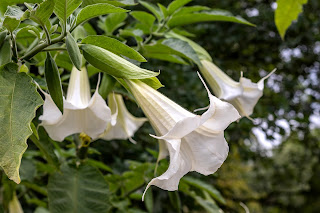
Angel’s trumpet is a species of evergreen or semi-evergreen plant in the nightshade family. This plant is also referred to as brugmansia. Angel’s trumpet is made up of seven different species that are native to South America. Angel’s trumpet became naturalized in tropical parts of Africa, Australia, Asia, and North America due to its beautiful flowers and interesting morphology. Angel’s trumpet prefers a warm climate, moist, well-drained soil, and direct sunlight. It is not frost tolerant. Angel’s trumpet is a popular ornamental plant. This plant is simple to grow, but it must be protected from pests such as glasshouse whitefly and mealybugs.
Angel’s trumpet grows as a bush or small tree. It can grow to a height of 10 to 36 feet.
Angel’s trumpet has large, alternately arranged leaves with tiny hairs.
Angel’s trumpet has large, trumpet-shaped flowers that can grow to be 6 to 20 inches long and 4 to 14 inches wide (fully open flower).
The flower is hung upside down. Pink, yellow, orange, red, green, or white are all possibilities. Angel’s trumpet blooms with both single and double flowers.
Angel’s trumpet flowers have a pleasant scent that is especially strong at night. Angel’s trumpet necessitates the attraction of moths (the primary pollinators of the flowers who are active at night).
Angel’s trumpet blooms in temperate climates during the spring, summer, and autumn. In tropical climates, it blooms throughout the year.
Angel’s trumpet can be grown from seed or from tree cuttings.
Angel’s trumpets are related to potatoes, tomatoes, eggplant, petunias, and tobacco.
Angel’s trumpet contains alkaloids, which are toxic compounds. They can be found throughout the plant. The highest concentration of alkaloids is found in the seeds and leaves. Humans are poisoned by these substances.
The first signs of intoxication appear soon after ingesting the plant (even the smallest piece).
Certain butterfly species consume Angel’s trumpet and store alkaloids in their bodies to increase their chances of survival in the wild. The high alkaloid content of the butterfly’s body makes it unappealing to most predators.
Angel’s trumpet parts can be used to cause euphoria and strong hallucinogenic effects. It has been reported that body parts have been cut while under the influence of Angel’s trumpets.
Because of the high content of toxic compounds, cultivation of Angel’s trumpet is prohibited in some communities.
Angel’s trumpet is used in South American folk medicine to treat skin irritation, dermatitis, arthritis, infections, headache, rheumatism, and various types of inflammations.
Because of their spasmolytic (muscle relaxing), anti-asthmatic, and anesthetic properties, alkaloids isolated from the plant (scopolamine, hyoscyamine, and atropine) have applications in medicine.
Angel’s trumpet is a perennial plant, which means it has a life cycle that lasts longer than two years.









